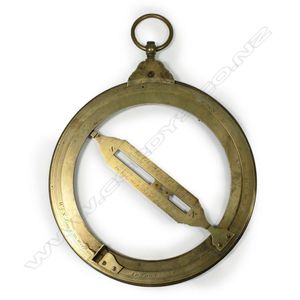18th Century Brass Sundial by W. & S. Jones
An 18th century brass 9 inch universal equinoctial ring dial [sundial] by W. & S. Jones, Holborn, London, circa 1790, two concentric brass rings folding flat, the chapter ring with hours I-XII-I-XII divided to 1 minute, equinoctial ring with degree scale in two quadrants and declination scale to reverse, the bridge with sliding pinhole gnomon on calendrical and zodiacal scales. Provenance: The H.N.E Sheppard Estate Collection.
You must be a subscriber, and be logged in to view price and dealer details.
Subscribe Now to view actual auction price for this item
When you subscribe, you have the option of setting the currency in which to display prices to $Au, $US, $NZ or Stg.
This item has been sold, and the description, image and price are for reference purposes only.
- Circa - A Latin term meaning 'about', often used in the antique trade to give an approximate date for the piece, usually considered to be five years on either side of the circa year. Thus, circa 1900 means the piece was made about 1900, probably between 1895 and 1905. The expression is sometimes abbreviated to c.1900.
- Equinoctial Dial on a Sundial - An equinoctial dial is a type of sundial that uses the equator as a reference plane and the gnomon, or sundial arm, is positioned perpendicular to the equator, which allows the sundial to be used in any location with a clear view of the sun and provides an accurate reading of local solar time.
Equinoctial dials were first developed in ancient Greece and were later refined by Arab astronomers. The dials became popular in Europe during the Renaissance, when they were used as both scientific instruments and works of art. Equinoctial dials were particularly popular in Italy, where they were often made of bronze or stone and were decorated with intricate engravings, sculptures, and inscriptions. The sundial as an instrument was superseded by the chronometer.
This item has been included into following indexes:
- sundials
